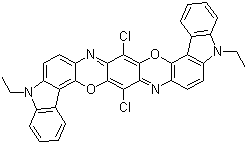Violet pigmenté 23
| Nom du produit | PIGMENT VIOLET 23 |
| Synonymes : | C.I.Pigment Violet 23; C.I.PV23; PV23; P.V.23 |
| CI | 51319 |
| N ° CAS. | 6358-30-1 |
| EINECS | 228-767-9 |
| Masse moléculaire | 589.47 |
| Formule moléculaire | C34H22Cl2N4O2 |
| Densité | 1.53g/cm3 |
| Couleur | Poudre de violette |

Formule de structure moléculaire :

Fastness Properties of Pigment Violet 23:
| Solidité à la lumière | 7 |
| Résistance à la chaleur (℃) | 200 |
| Résistance à l'eau | 5 |
| Résistance à l'huile | 5 |
| Résistance aux acides | 5 |
| Résistance aux alcalis | 5 |
| Résistance à l'alcool | 5 |
Application principale : Encre à base d'eau, Encre offset, Encre à base de solvant, Plastique, Peinture, Impression textile
Nous avons différentes qualités et propriétés de pigments pour répondre aux différents besoins des clients, veuillez spécifier votre application et vos exigences afin que nous puissions vous recommander en conséquence. Courriel : sy@sypigment.com
Product Description of Pigment Violet 23:
Mainly used for coloring of coatings, inks, rubber and plastics, and also used for coloring of synthetic fibers.Carbazosin is a violet product with strong comprehensive application and unusual high color strength. The specific surface area of Monolite Violet RN is 74m2/g. Widely used in coatings, printing inks, plastics and fabric printing and dyeing, etc.: It has good fastness to varnish when the coating is colored. It can be used for air-drying paint, automotive coating OEM and baking paint, especially for CuPc color mixing. It is used for coloring of plastics, heat-resistant to 280°C in polyolefin, and has high tinting strength (HDPE up to 1/3SD only needs a pigment concentration of 0.07%); also used for polyester and PE raw materials Pulp coloring.
Pigment violet 23 is an organic compound that is a commercial pigment. It is member of the dioxazine family of heterocyclic compounds, but derived from carbazoles. It is prepared by condensation of chloranil and 3-amino-N-ethylcarbazole. It has a centrosymmetric angular structure. For many years, the structure was assigned, incorrectly, as having a "linear structure" (EC no. 228-767-9, CAS RN 6358-30-1) which differ in terms of the carbazole ring fusion.
Pigment violet 23 is prepared by condensation of an aniline with chloranil.
TDS (Pigment Violet 23) MSDS (Pigment Violet 23)Synonymes
- 6358-30-1
- C.I. Pigment Violet 23
- Carbazole Violet
- Dioxazine Violet
- UNII-8U8Z6628KF
- 8U8Z6628KF
- 2,20-dichloro-14,32-diethyl-18,36-dioxa-4,14,22,32-tetrazanonacyclo[19.15.0.03,19.05,17.07,15.08,13.023,35.025,33.026,31]hexatriaconta-1,3,5(17),6,8,10,12,15,19,21,23(35),24,26,28,30,33-hexadecaene
- 8,18-Dichloro-5,15-diethyl-5,15-dihydrodiindolo(3,2-b:3′,2′-m)triphenodioxazine
- Permanent Violet R
- Cyanadur Violet
- Heliogen Violet
- Dioxazine purple
- Permanent Violet
- Lionol Violet HR
- Lionogen Violet RL
- Sandorin Violet BL
- Vynamon Violet 2B
- Hostaperm Violet RL
- PV Fast Violet BL
- Chromofine Violet RE
- Lake Fast Violet RL
- Unisperse Violet B-E
- Carbazole Violet Crude
- Helio Fast Violet BN
- Lake Fast Violet RLB
- EMC Violet RL 10
- Monolite Fast Violet R
- Heliogen Violet R Toner
- Paliogen Violet 5890
- Heliofast Red Violet EE
- Sumitone Fast Violet RL
- Symuler Fast Violet BBL
- EB Violet 4B7906
- Fastogen Super Violet RN
- PV Fast Violet RL-SPE
- Sumitone Fast Violet RLS
- Carbazole Dioxazine Violet
- Symuler Fast Violet BBLN
- Fastogen Super Violet RTS
- Fastogen Super Violet RVS
- Lionogen Violet R 6100
- Paliogen Violet L 5890
- Sumikacoat Fast Violet RSB
- Hostaperm Violet RL Special
- Fastogen Super Violet RN-S
- Sumitone Fast Violet RL 4R
- SCHEMBL342958
- DTXSID2036293
- Sanyo Permanent Violet BL-D 422
- EINECS 228-767-9
- MFCD00281166
- ZINC100507961
- Hostaperm Violet RL Special 14-4007
- CI 51319
- FT-0623456
- D94662
- EC 228-767-9
- Q27271021
- 8,18-Dichloro-5,15-diethyl-5,15-dihydrodiindolo(3,2-b:3′,2′-m)tri- phenodioxazine
- Diindolo(3,2-b:3′,2′-m)triphenodioxazine, 8,18-dichloro-5,15-diethyl-5,15-dihydro-
- Diindolo(3,2-b:3′,2′-m-)triphenodioxazine, 8,18-dichloro-5,15-diethyl-5,15-dihydro-
Nom IUPAC : 2,20-dichloro-14,32-diethyl-18,36-dioxa-4,14,22,32-tetrazanonacyclo[19.15.0.03,19.05,17.07,15.08,13.023,35.025,33.026,31]hexatriaconta-1,3,5(17),6,8,10,12,15,19,21,23(35),24,26,28,30,33-hexadecaene
InChI : InChI=1S/C34H22Cl2N4O2/c1-3-39-23-11-7-5-9-17(23)19-13-21-27(15-25(19)39)41-33-29(35)32-34(30(36)31(33)37-21)42-28-16-26-20(14-22(28)38-32)18-10-6-8-12-24(18)40(26)4-2/h5-16H,3-4H2,1-2H3
InChIKey : CGLVZFOCZLHKOH-UHFFFAOYSA-N
SOURIRES canoniques : CCN1C2=CC=CC=C2C3=CC4=C(C=C31)OC5=C(C6=NC7=C(C=C8C(=C7)C9=CC=CC=C9N8CC)OC6=C(C5=N4)Cl)Cl
| Nom de la propriété | Valeur de la propriété |
| Masse moléculaire | 589.5 |
| XLogP3-AA | 8.2 |
| Nombre de donneurs d'obligations hydrogène | 0 |
| Nombre d'accepteurs de liaison hydrogène | 4 |
| Nombre d'obligations rotatif | 2 |
| Masse exacte | 588.1119813 |
| Masse monoisotopique | 588.1119813 |
| Surface polaire topologique | 53 Ų |
| Nombre d'atomes lourds | 42 |
| Charge formelle | 0 |
| Complexité | 1180 |
| Nombre d'atomes isotopiques | 0 |
| Nombre défini de stéréocentres d'atomes | 0 |
| Nombre de stéréocentres d'atomes non définis | 0 |
| Nombre de stéréocentres de liaison définis | 0 |
| Nombre de stéréocentres de liaison indéfinis | 0 |
| Nombre d'unités liées par covalence | 1 |
| Le composé est canonisé | Oui |


